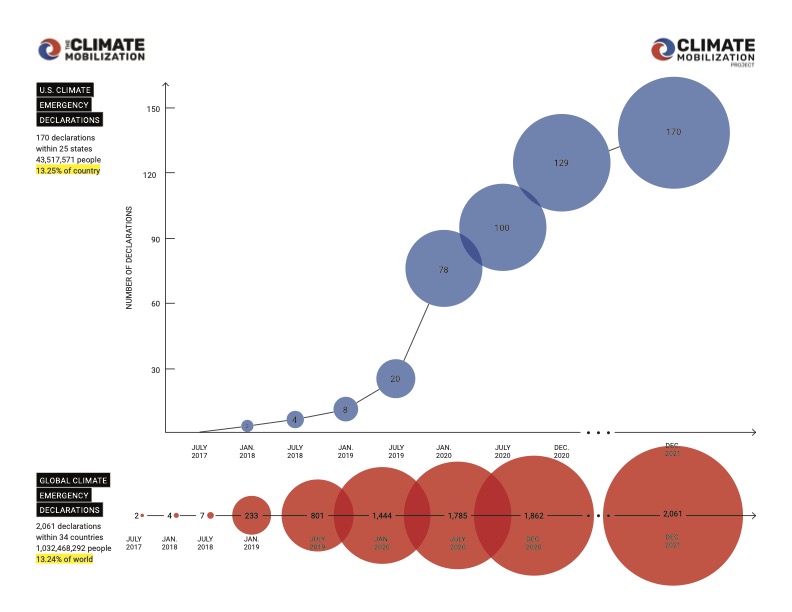In communities around the world, people are coming together to help each other, prepare for the struggles ahead and put an end to the way of doing things that has brought us here.
When you fill out the form below, you’ll get a step-by-step blueprint for mapping your community’s resources and beginning to plan a Climate Survival program rooted in disaster preparedness or mutual aid.

We are planning Climate Survival Movement Incubation Gatherings for 2023 and beyond. If you are part of a local group interested in mutual aid, direction action and healing — a joining a collective movement for climate survival, join us!
Read more about Climate Survival Movement Incubation here. If you are part of a local group interested in learning more or want to join, fill out the form below.

We offer a step by step blueprint for people and organizations to get their communities involved by passing Climate Emergency Declarations, and follow-up policies, Climate Emergency Programs. Whether you’re an individual, or part of a local climate group in your community, we make it easy to move your community into emergency mode on climate.
We’ll send you an organizer toolkit and opportunities to get connected with a network of climate emergency organizers.

Zakaria Kronemer is a farmer from Richmond, Virginia with roots in community organizing and climate activism. In 2017, he began working with farmers and other communities in rural Virginia to develop a robust campaign against the construction of two fracked-gas pipelines. It was through this struggle —and the relationships built along the way—that connections between food, land, and climate justice were revealed to him. He teamed up with other BIPOC farmers and set out to build an alternative, regional food-system founded on sovereignty, security, ecological stewardship, and human dignity. Zakaria most recently worked as a field manager and program lead with Real Roots Food Systems—an emerging organization striving to increase participation in our food system. He envisions a food system that people can meaningfully participate in without needing to become a farmer, chef, or professional, in which nutrient-dense, healing food is not a luxury or a lifestyle, but a right.

Daisy Carter (she/they) is a New Orleans native, queer multi-disciplinary artist and climate justice organizer working at the intersections of mutual aid, disaster resiliency, African-American herbalism, and grassroots organizing. Daisy is inspired by the black radical movements of the so-called U.S and African diaspora, reimagining what healing + self-determination look like for frontline, BIPOC (black, brown, and people of color) communities who are most vulnerable to climate disaster. For the past few years, they have been organizing around mutual aid, environmental + climate justice, and building BIPOC and marginalized leadership throughout Kentucky. In 2021, they founded Rise and Shine, a community-led mutual aid organization building power and solidarity with low-income, BIPOC, LGBTQ+, and other marginalized communities in Bowling Green, Kentucky and beyond. She has also led numerous political campaigns, direct actions, and led outreach + communications strategy for organizations such as The Sierra Club, Kentuckians for the Commonwealth, and the Poor People’s Campaign: A National Call for a Moral Revival. At the Climate Mobilization, she is supporting programming, the development of the Movement Incubation Program, and the creation of climate survival outreach projects.

Alexia (she/they) is an environmental justice organizer based in Austin, TX. They graduated summa cum laude from NYU (’20), where they self-designed a major titled “The Politics and Economics of Inequality.” Their research focuses on political ecology, environmental justice, AAPI communities, inequality, postcolonialism. As an organizer and researcher they have spent the past 5 years working on various issues from preserving the Colorado River, water rights, fighting land use policy and zoning that enforces race-based discrimination, conducting ethnographic research on climate health, to organizing mutual aid, youth programming, and shaping national legislation alongside members of the Environmental Justice Leadership Forum and the Environmental Justice Health Alliance; today Alexia continues to work as an organizer with PODER, a grassroots EJ org. Alexia is also the co-founder of Start: Empowerment, a BIPOC led social and environmental justice education non-profit working with youth, educators, activists, and community members to implement justice-focused education and programming in schools and community spaces. S:E curriculum and programming has reached over 2,000 students, been recognized by the NYC Department of Education, and taught in universities. In 2021, their work was recognized by the prestigious Brower Youth Award.


Emmett manages operations and leads Climate Mobilization’s intersectional organizing around transportation justice, where he works with local community groups to build commitment, alignment and action among frontline constituents who rely on public transit and active transportation modes. He brings over a decade of experience collaborating with diverse stakeholders to activate power towards equitable, climate-friendly transportation systems, build mutual-aid-based community food systems, ensure equitable access to public lands, and mobilize resources towards a just transition. In 2021, Emmett developed an online platform for collaborative, community-scale visioning of a just, zero-carbon future. In 2022 he helped launch a transit riders union in Sonoma County, CA, which has engaged in mutual aid, storytelling, and a successful campaign to win fare-free buses and expanded frequency.

National Organizer Suha Dabbouseh leads national strategy for The Climate Mobilization. They are originally from Chicago but have lived, organized and rebel-roused in seven states and 11 cities. Suha received their law degree from CUNY-School of Law where they focused on social justice lawyering representing detainees at Guantanamo Bay. While practicing law, Suha had worked to advocate on behalf of domestic violence survivors, transgender clients and fighting employment discrimination. Their passion is building people power and organizing to dismantle structural inequities.

Matt has worked as a nonprofit executive in clean energy, climate policy, and journalism for over a decade, focusing on the near-term social and economic impacts of climate change. He leads organizational expansion and works closely with the communications and organizing teams. Matt earned a BA in political science from UC Berkeley, where he was deeply inspired by the work of Professor George Lakoff.

Mariyah is a first-generation Pakistani community organizer who is on a life-long journey of working to create alternative, anti-capitalist models of collective healing, popular education, community organizing, and mass movement. She has been inspired by studying social movements and organizing in many movement ecosystems and geographies – most recently in Cape Town, Iowa, Puerto Rico, Atlanta, and currently in Los Angeles. At Climate Mobilization, she started as a Network Organizer where she leads programming, coaching, and other resource development for a learning hub of 43+ local decarbonization and climate justice campaigns. She also recently developed strategy for youth, BIPOC-led, climate movements alongside the Network Support Team at Power Shift Network, and organized with the Asian Pacific Environmental Network to base-build in Wilmington and San Pedro alongside low-income API communities most impacted by extractive industries in Los Angeles. Mariyah has spent the past 7 years leading campaigns for Just Transition, abolition, food sovereignty, housing justice, undocumented workers’ organizing, reproductive justice, and Palestine solidarity as well as being involved in mutual aid projects, across more than 15 geographies.

Rebecca has been with Climate Mobilization since 2019 leading our organizing efforts. In this role, she has coached dozens of local climate groups, coordinated organizing trainings, and launched the campaign for a national Climate Emergency Declaration. In July 2021, she collaborated with Acton, MA residents to launch Housing and Climate Justice for Acton, a renters rights and climate justice group led by public housing and Section 8 renters and other low-income residents, and has already won several campaigns. Along with a history of social movement organizing, Rebecca previously worked as a journalist covering equity in Chicago public schools and as the Development and Communications Manager at Latino Union of Chicago, an immigrants’ and workers’ rights organization. She is a 2017 graduate of the Reframe Mentorship in strategic communications and a 2019 participant in the Anne Braden Organizer Training Program.


Meghann brings more than 20 years of nonprofit management and fundraising experience to The Climate Mobilization and Climate Mobilization Project. For over a decade Meghann has worked as a nonprofit consultant helping organizations expand their capacity, secure revenue, develop successful strategies, and effectively evaluate their programs, enabling them to create greater positive change in the world. She has also worked as an executive director, designed and facilitated international service learning experiences, and taught university courses in fundraising and nonprofit management. Meghann earned a MPA in Nonprofit Management and Comparative and International Affairs from The School of Public and Environmental Affairs at Indiana University, in Bloomington, IN and a BA in Art History and American Studies from Tufts University in Boston, MA.

Cris is helping to grow the Climate Emergency Movement by supporting creative campaigns and extending the reach of the movement’s message. Cris is a co-founder of the National Immigrant Youth Alliance, an organization dedicated to using direct action tactics to expose, challenge and dismantle the immigration detention system.Cris got his start in organizing when he was 15 years old, getting involved in a local group of fellow undocumented youth.

Zack provides policy support for the Climate Mobilization team, and brings a versatile set of policy skills and experiences in labor organizing, journalism, legislative politics, and legal practice to the climate emergency movement. Zack earned a JD from Denver University Sturm College of Law, is a founding organizer of the Political Workers Guild of Colorado, and formerly served as a legislative aide in the Colorado General Assembly.

AriDy Nox is a multi-disciplinary black femme storyteller and social activist with a variety of forward-thinking creative works under her/their belt. They create out of the vehement belief that creating a future in which marginalized peoples are free requires a radical imagination. Their tales are offerings intended to function as small parts of an ancient, expansive, awe-inspiring tradition of world-shaping, created by and for black femmes. They have over a decade of experience as a young social activist and organizer, within reproductive justice and racial justice frameworks with organizations like the Young Women of Color Leadership Council with Advocates for Youth, the Toni Cade Bamabara Collective at Spelman College and Alpha Kappa Alpha Sorority Incorporated. They bring creativity, enthusiasm and a tremendous capacity for organization to her/their role and deep belief that times of apocalypse are opportunities for rebirth. We need first imagine the world we want in order to create it.